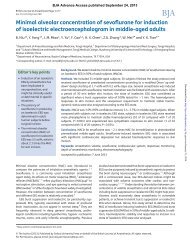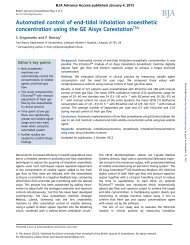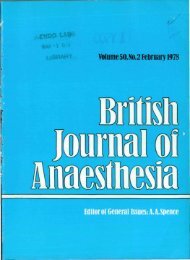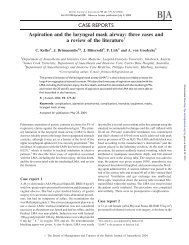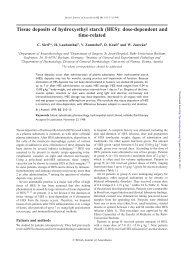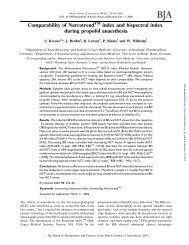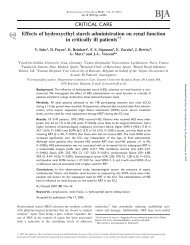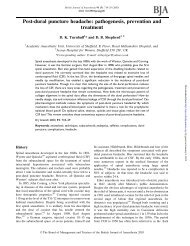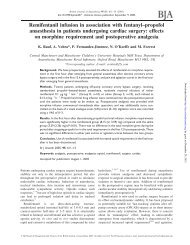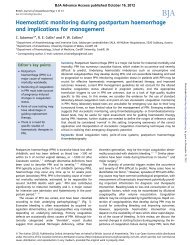Front Matter (PDF) - BJA
Front Matter (PDF) - BJA
Front Matter (PDF) - BJA
Create successful ePaper yourself
Turn your PDF publications into a flip-book with our unique Google optimized e-Paper software.
Xll BRITISH JOURNAL OF ANAESTHESIA<br />
Illustrations<br />
Photographs should be unmounted glossy<br />
prints, and should be protected adequately for<br />
mailing. Surfaces should not be marred with<br />
clips, pins or by heavy writing on the back.<br />
Drawings, charts and graphs should be in black<br />
india ink on white paper and, if in sets, should be<br />
presented at a uniform magnification. Illustrations<br />
should be clearly numbered on the back, preferably<br />
in soft pencil, with reference to the text,<br />
and using arabic numerals. They should be<br />
accompanied on a separate sheet by a suitable<br />
legend. Lettering should be professional-looking,<br />
uniform, preferably in a common typeface, large<br />
enough to read at a reduced size, and in proportion<br />
to the illustrated material. Lines in the original<br />
must also be thick enough to allow for reduction.<br />
Magnifications, especially in photomicrographs,<br />
should be indicated by a scale on the photograph<br />
itself, in order to remain appropriate after<br />
reduction. Symbols which are to appear in the<br />
legend should be chosen from the following<br />
available types:<br />
• O a • v • A • o<br />
The name of the author and title of the paper<br />
should also be written in soft pencil on the back of<br />
the illustrations.<br />
It is emphasized that care taken in the original<br />
preparation of figures will obviate the time-consuming<br />
and expensive necessity of their revision.<br />
General information<br />
Instructions to the printer. Words to be printed<br />
in lower-case italics should be indicated by one<br />
underline. Two underlines indicate small capitals,<br />
three indicate large capitals and four, italic<br />
capitals. A wavy underline indicates a word to be<br />
printed in bold type.<br />
Headings in the text. Six possible grades are<br />
available, and may be indicated by the following<br />
letters of identification:<br />
A PART I (capitals)<br />
B RESULTS (small capitals)<br />
C Blood-Gas Analysis (I.e. roman)<br />
D The Action of Drugs (italics, centre)<br />
E Lung function studies (italics, full out)<br />
F Volume. Large volumes... (italics, indent)<br />
Symbols and Abbreviations. In accordance with<br />
Editorial adoption of SI Units, abbreviations and<br />
symbols should follow the conventions described<br />
in the booklet Units, Symbols and Abbreviations. A<br />
Guide for Biological and Medical Editors and<br />
Authors (ed. G. Ellis), published by and available<br />
from The Royal Society of Medicine, 1 Wimpole<br />
Street, London, W1M 8AE. Words for which<br />
abbreviations are not included should be written<br />
in full at first mention in the summary and again<br />
in the text and followed by the abbreviation in<br />
brackets. This will usually be in the form of large<br />
capitals without separating points.<br />
Spelling, etc. British spelling should be used<br />
with "z" rather than "s" spelling in, e.g.<br />
organize, organization.<br />
SHORT, RAPID COMMUNICATIONS<br />
Authors are encouraged to submit short manuscripts<br />
suitable for rapid publication. In general,<br />
these should conform to the requirements outlined<br />
above, but with the following differences:<br />
Format. Summary; Introduction (not headed);<br />
Methods and Results; Comment.<br />
Size. Not more than: 6 references, 1 table or<br />
1 figure, one-and-a-half pages of printed text<br />
(1200 words).<br />
CORRESPONDENCE<br />
It is proposed that a proportion of the Journal be<br />
devoted to correspondence each month. Every<br />
effort will be made to ensure that correspondence<br />
arising from papers in a recent issue is published<br />
without delay, and for this reason, relevant<br />
correspondence will be given priority over that<br />
pertaining to original research. Authors of correspondence<br />
concerning original work will receive<br />
proofs at the Editor's discretion.<br />
PROOFS<br />
These should be corrected and returned to the<br />
technical editor within 48 hours of receipt. Overseas<br />
contributors should return their proofs by airmail.<br />
REPRINTS<br />
Twenty-five reprints of articles will be dispatched<br />
to the authors after publication. Further reprints<br />
can be supplied if application is made on the order<br />
form attached to the proofs. The order form<br />
should be returned with the proofs.



